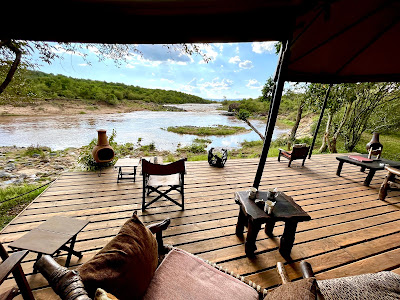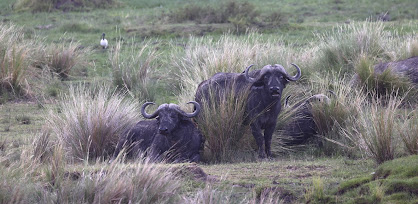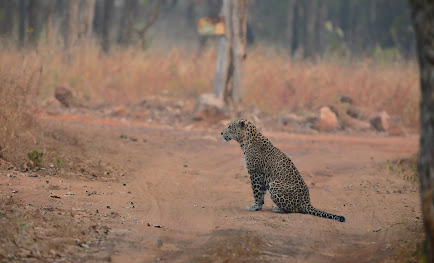My love affair with nature and wildlife photography started with a chance head-on encounter with a Royal Bengal Tiger in the narrow winding ghat roads of Amarkantak. It was way back in late eighties. I was working then with Raymond at their cement plant at Bilaspur. The company had given me a new Padmini car under their 'Own Your Car Scheme' and that facilitated my journeys to Lucknow , my home town, on annual leaves which I used to take usually at the year end in the month of December. The Durg - Sarnath Express, the present day daily train between Allahabad and Durg, was a weekly train then sans any air conditioned coach.
So on one December morning we four - my wife, her mother, my five years old son Akash and me, left Bilaspur early in the morning. The idea was to reach Allahabad before sunset in order to avoid the winter evening fog which one finds enveloping the road on approaching U P border. I was keen to pass the Sohagi Ghati area before sunset.
By 8 a. m. we were on the Amarkantak plateau. I was happy to maintain time. In the next 15-20 minutes the winding ghat road was to come to an end. Thereafter road was mostly straight and I could speed.
Anyone who has driven in that sector will recall Amarkantak plateau's straight road turning into a deep incline at its end towards Shahdol. That very steep gradient runs for about 800 meter or so with two equally extreme hairpin bends in between marking end of the first and start of the second leg of that dangerous road section. It demands total concentration on the part of the driver. Any slip can send one down into the deep khadd.
I had driven past almost half of the slope. Driving slow in 2nd gear I was concentrating negotiating the first steep hairpin bend which was ahead and to come in a minute. I then felt my wife's hand pressing my left shoulder, a light press followed by a quick hard one like dits and dahs of the Morse code. "Don't worry. I see the bend " said I to assure her.
"Oh , don't be silly. Stop and look to your left". There was a note of alarm in her voice. Applying brakes gently I pulled the hand brake lever backwards to the full lest the car rolls down the slope and turned my head leftwards as commanded. The car engine was running.
My searching eyes glanced the leftward area but failed to find anything noticeable. "Where, where", I asked Damini, my wife. Pointing her finger across the windshield she guided my vision to a point which was about 20 feet distant from the car. "Look there in the grass"she said.
There, at the spot amidst green - yellow 4-5 ft tall flowering jungle grass I noticed a faint rustling movement and then something round in shape of orange-yellow color with black markings and double the size of a number five football peeped out. Nest appeared a white-yellow striped leg ending its suspension from the air to terra firma very slowly like the start of Michel Jackson's moonwalk. That round massive head turned slowly first to left and then to right , in our direction , as if doing a reconnaissance.
There was a strange kind of eerie. Frankly admitting my brain's information processing function went for a toss for a few milliseconds . "What is that " I asked Damini in a state of utter confusion.
"Don't you see that Tiger. You dimwit " came back the retort. A tiger. Oh my God ! A fearful realization hit me instantly. I wanted to speed away. Instinctively my left hand reached to lower the hand brake lever.
"Don't do anything silly. Cut down the engine" said Damini. By that time the tiger , out of the grass cover, had started walking slowly in our direction perhaps to to see the jokers who were about to cross his path encased in some nonsense looking white metal contraption.
Car windows rolled up in a jiffy and doors locked hurriedly, our eyes got fixed at the beast walking head on in our direction. My heart thumped in a fearful apprehension. Will the brute attack our car? Why not to frighten him before he does that! My fingers reached for the circular horn pad in the steering wheel only to be brushed away by a swift forceful sweep of Damini's hand.
"Sit tight . Horn my startle him and he may charge" came the stern advice.
The tiger, its head down, kept walking majestically in the middle of the road in our direction. In the diffused sunlight its shimmering winter coat looked magical. His stout body with its rhythmic rippling of shoulder and neck muscles at every step that he took, presented a cat-walk of a totally different kind.
Öh , he is very near " exclaimed Damini taking me out of the trance. I kept mum, as anyone could imagine , for after all what could I say in that state of mind. Next happened the unexpected. The feline stopped in its tracks for a second. Then lifting the head up he gave us a brief visual inspection as close as about 7 ft from the car. And perhaps not finding us worth to his stature , the King walked down the road vanishing in the woods.
"Hey bhagwan. Aaj to merte-merte bachey " ( O'God. What a close escape from death today ) The voice from the back seat broke the pin drop silence in the car . That was my mother - in -law trying to regain her composure with a swig from the water bottle. But the best came from Akash who I thought was asleep. "Daddy can I step out and watch the tiger going"!
Happy ending. We reached Allahabad before sunset. Liberal doses of tea and tips on driving manners from Damini helped.
II
That brief meeting with tiger ignited my passion for wildlife photography but I had no camera. So I requested Capt. Prabhakar, the Chief Pilot of Raymond to get me one. As luck would have it Capt. Prabhakar was to leave soon for Singapore for fitting of some new avionics in the company's aircraft and when he landed back at Bilaspur a month later I was presented an Olympus OM-2N body along with Zuiko 50 mm and 100 mm telephoto lenses. I frequented Achanakmar forest regularly on every Sunday thereafter hoping to see a tiger and taking a shot from my new acquisition. But the animal did not oblige. In the meanwhile my job had started demanding time and therefore camera had to be put back in its bag. Nevertheless I learnt and my understanding of photography gradually improved.
In 2001 I came to Indogulf Fertilisers , Jagdishpur. There in its verdant campus my bungalow abutted a 6 acres of man made forest and home to about two dozen Peacocks, many Monitor Lizards, a pack of Jackals, few Pythons and a variety of birds. Sort of a mini zoo. Beautiful roses and other seasonal flowers were another visual delight. I started thinking of picking up camera again and thus while returning from one of my foreign jaunts I picked up a DSLR and a telephoto lens.
All this went on fine but deep somewhere in the heart the dormant longing to click tiger in its environs got live again. Unable to suppress any longer I ranged up a wildlife photographer friend on mine for advice. After hearing me patiently he gave me some appreciable tips. He said that I shouldn't be "tiger - centric" but aim for the entire gamut of wonderful fauna that our country is endowed of and before embarking I must read as much as I can about tiger to know the animal. He said that wildlife photography was arduous and time taking . He doubted I was really ready for it. In a way he was right.
As advised I went for the wildlife literature whatever I could lay hands on. Books by Prater, Champion, Kipling, Sterndale, Jim Corbett and Anderson et al were read. That gave me lot of awareness about nature , tiger and biodiversity.
After retirement in 2011 I had lot of time. So giving a start to my long pending desire I started visiting tiger reserves. Bandhavgarh, Tadoba and Pench are my favorites. I tried the neighboring Dudhwa also but gave up after sometime finding it not photographer friendly. A beautiful park but needing professional management.
Photographing tigers has been a memorable phase of my life and the feline impressed me thoroughly. Suffice to say that tiger is the most majestic animal both in appearance and personal traits. No other wild animal can equal tiger. In 2017 I authored a book on tiger titled "The Vanishing Stripes". The book was rated as 'most authentic' work on Royal Bengal Tiger in India.
III
Of late wildlife and nature photography had become very popular in the country. The advent of digital cameras and rising income levels have made this possible. More and more people now are drawn to tiger reserves to see the Royal Bengal Tiger and click him in his natural habitat. That is very heart warming. But simply being a wildlife photographer is not enough. The increasing number of tiger lovers in the country must advocate the cause of conservation also as our jungle are being cut mercilessly in the name of infrastructure and development. Our greed and destructive genius both combined together are destroying nation's flora and fauna . We are losing our wilds and wetlands at an alarming rate. Wild denizens are short of living space and falling prey to snare , poison and bullet in search of home. And now that the words "poor"and "adivasi" have acquired a strong political connotation , tiger and jungle both face an aggravated danger of being destroyed in the name of "public welfare" as we saw it happening in the recent past in Maharashtra. On the other hand we have not been able to prevent large scale poaching that goes on unabated , unreported and assuming form of a lucrative profession. This year we have lost about 400 Leopards, 80 Elephants and more than 100 Tigers , the ratio of natural vs. unnatural deaths being 40:60 respectively. It is very sad to read that we are left now with less than 150 Great Indian Bustards or that our unique One Horned Rhino is being killed at the rate of one animal per month for its horns, The present trend continuing , India may be devoid of its jungles and wildlife in the next 50 years. Generations coming after us will see the wild animals only in photographs. Books may read like "once upon a time there used to be forests and tigers in India". With that thought , as a wildlife and nature photographer, I seem to be doing a good job - for the posterity.
___________________________
<script async src="https://pagead2.googlesyndication.com/pagead/js/adsbygoogle.js?client=ca-pub-2331515138562989"
crossorigin="anonymous"></script>




















































